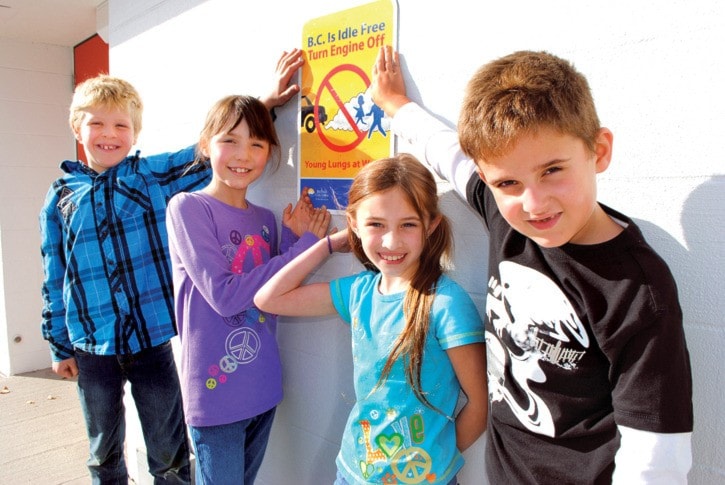Unnecessary idling of a vehicle is something everyone can be guilty of.
Yet if Canadian motorists avoided unnecessary idling for just three minutes every day of the year, it would prevent 630 million litres of fuel from being wasted and 1.4 million tonnes of carbon dioxide from being needlessly pumped into the environment.
“Annually, that would be the equivalent of taking 320,000 cars off of the road,” says Tammy Keetch, Williams Lake air quality educator.
This week Keetch has challenged students, staff and parents at local elementary schools and Thompson Rivers University (TRU) in Williams Lake to take the pledge to be idle free.
“We’re just trying to raise awareness about the facts about idling. There are lots of myths out there. This campaign is about getting the right information,” Keetch explains.
Participating schools include Mountview, Chilcotin Road, Cataline, Nesika, Big Lake, Horsefly, and Lac La Hache Elementary along with the Nursing Department at TRU. Some of the schools have participated this week, others will at a later date.
Keetch has distributed information to the schools and the school board, along with free Idle Free Zone signs for school parking lots.
“Parents are the worst offenders,” she adds.
The Idle Free pilot campaign supports the School District’s recent renewal of their Anti Idling of Engines Policy for buses and equipment and the Vehicle and Equipment Idle Free policy of the City of Williams Lake, Keetch adds. Studies by Health Canada and community health departments have shown a direct link between air pollution and significant respiratory health effects.
“Children are really vulnerable to air pollution because they are still developing and because they breath more. They are lower to the ground than adults so they are closer to the source of pollutants,” Keetch says.
They spend more time outdoors being physically active, and they breathe faster than adults and inhale more air per kilogram of body weight.
“Even healthy children, who are active outside during high pollution episodes, may develop respiratory symptoms, such as throat irritation, coughing, wheezing, and shortness of breath or chest tightness,” she says, adding adults need to be advocates for children.
Taking the challenge means anytime your car is running, but stopped for more than 10 seconds, except in traffic, turn it off.
“Experts have determined that after ten seconds of idling your car is using more fuel than it takes to turn off and restart the engine. Maybe your teen drives a car; does he or she know not to idle? Start them out right with a lesson on car maintenance and the ten second rule of idling,” Keetch suggests.
Vehicle exhaust contains more than 40 hazardous air pollutants and carcinogens. Studies show that exposure to vehicle exhaust can increase risk of respiratory illness and cancer.
In Williams Lake, the major air quality issues include unhealthy levels of fine particulate matter (PM 2.5 and 10) and ground-level ozone. Idling contributes to these issues, Keetch says, adding PM 2.5 is of more concern, because it is small and can penetrate deep in the lungs.
With winter coming up Keetch says once a vehicle is running the best way to warm it up is to drive it.
“With computer-controlled, fuel-injected engines, you need no more than 30 seconds of idling on winter days before driving away. The tires, transmission, wheel bearings and other moving parts also need to be warm for the vehicle to perform well. Most of these parts don’t begin to warm up until you drive the vehicle.”
